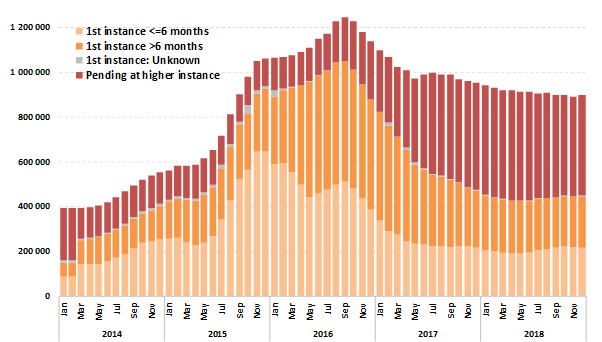Once an application for international protection has been lodged with the responsible authority, the processing phase begins. The final outcome of this process is a decision at first instance, sometimes followed by another decision at appeal. However, the examination of a case can be closed for other reasons, including an explicit withdrawal by the applicant, an implicit withdrawal for example in the case of absconding, and acceptance of responsibility by a partner country in the context of a Dublin procedure. While an application is under examination, it is part of the stock of pending cases. Pending cases are an important indicator of the workload experienced by national authorities and the pressure on national asylum systems, including reception systems.
|
Pending cases in the EU+ at the end of each year |
 |
|
Figure 23: At the end of 2018 the stock of pending cases at all instances was only slightly lower than a year earlier |
At the end of 2018, some 896 560 applications were awaiting a final decision in the EU+. This was only 6 % less than those at the same time in 2017 but 21 % less than those at the end of 2016 (Figure 23). A decline was registered for the second year in a row. Nevertheless, the number of pending cases at the end of 2018 was considerably higher than at the end of 2014.
Eurostat data presented in Figure 23 do not distinguish between procedural stages at which applications are pending and the time elapsed since the lodging. Therefore, we combine Eurostat data with EASO data on cases pending at first instance, which can be disaggregated according to duration of up to six months and longer. While EASO data are provisional and not validated, they are sufficient to indicate overall trends at EU+ level. Juxtaposing Eurostat and EASO statistics enables deeper insights into trends in the processing of applications.
Figure 24 shows that pending cases at all instances were declining gradually throughout 2018. This reduction of the stock was in fact visible primarily for cases pending at second and higher instances, in particular in the second half of the year 130. In contrast, at first instance, there was a small reduction in the number of cases awaiting a decision in the first months of 2018 but in the second half of the year the stock began increasing such that the level in December more or less returned to the level of January. As a result, the number of cases pending at first instance was almost equal to the number of cases pending at second and higher instances, each at about 448 000. Consequently, at the end of 2018 the pressure on national asylum systems seemed to be equally distributed between asylum authorities and judicial bodies.
|
Evolution of pending cases in the EU+, by instance |
 |
|
Figure 24: During the second half of 2018 a decrease in the number of cases pending at higher instances was only partially offset by an increase at first instance |
The overall rise in the stock of cases pending at first instance in the second half of 2018 was reflected only in cases pending for up to six months, whereas the number of applications awaiting a decision for a longer period declined slightly. This means that newly lodged applications contributed to the growth in the stock at first instance. This is in line with a slight decrease in the number of decisions issued at first instance in the second half of 2018 combined with a slight increase in the level of applications lodged.
___
130 The overall number of pending cases presents Eurostat statistics, while the temporal breakdowns at first instance are derived from EASO data.

